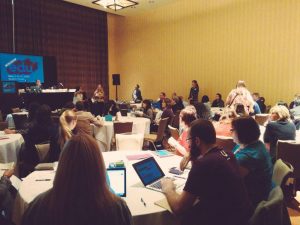Written By: Matt Walker
Age 15, High School Freshman and dyslexic.
 I was sitting at a table in The Austin Convention Center with school principals, teachers, parents, and app developers all eager to experience what it was like to have a learning disability. Â They wanted to understand how it affected the kids in their classrooms and what it was like for them. Â Hundreds of adults were about to participate in a classroom experience by using props to simulate different learning disabilities.
I was sitting at a table in The Austin Convention Center with school principals, teachers, parents, and app developers all eager to experience what it was like to have a learning disability. Â They wanted to understand how it affected the kids in their classrooms and what it was like for them. Â Hundreds of adults were about to participate in a classroom experience by using props to simulate different learning disabilities.
The air smelled of blue raspberry as wrappers were torn off blow pops and some adults were told to put them in their mouth for the entire classroom experience.  At first, there was laughter as they enjoyed the sugary treat, but that quickly faded and smiles turned into frustration.  The teachers running the session kept telling them that they couldn’t understand what they were saying and kept asking them to speak more clearly.
Others had it worse. Some adults were given blindfolds or glasses with waxy Chapstick smeared over the lenses. The adults with blindfolds were in complete darkness and had to ask others around them what was going on. Â They got yelled at for speaking in class. Â Many adults were given multiple disabilities. Â Ear plugs were put in and their hands were taped together.
The lights dimmed and a disco ball shot flecks of light across the room. One adult had to leave because she said she would have had a seizure if she stayed.  A Brainpop movie about dyslexia was shown as the lesson.  When the movie was finished, teachers handed out pens and a quiz.  The blind student just sat there.  The people with their hands taped together could be heard whispering, “This is stupid. How am I supposed to write?†The teacher yelled at them for their attitude.
When the lesson was over the leaders of the session asked the participants how it felt.  Many talked about how mean they thought the teacher was.  One guy with a blindfold on said, “I may as well not even been here.† Then one of the teachers went over to a lady they had sent in the corner before the lesson began.  They had told her to go in the corner and put headphones on while she played with an iPad. They tapped her on the shoulder and asked her to take off her headphones. Next, they asked her how she felt.  She said she felt invisible. It was a complete role reversal.
While the presentation of assorted educational products went on, I was thinking to myself this is the best way of explaining what it’s like to have a learning challenge I have ever seen. It had the perfect scenario along with the perfect negative reinforcement (the yelling teacher), and had the proper tools to represent the disabilities. My only wish is that all my past teachers could have this same experience, not just the bad ones, but all of them.  It’s important for them all to experience that having a disability in the classroom is a real problem and not just some made up thing, something you can fake having, or that you’re just not trying hard enough. This experience made my trip. I am glad I went just for this experience and I hope more educators go through an experience like this so they can see what it’s like to be me.
Matt is the inspiration behind the app Choiceworks.
Matt participated in the SXSWedu workshop entitled Inclusive AppRoom: Viewing Apps Through Disabilities organized by BridgingApps.org, Teaching2gether, and Locomotive Labs.
Related Resources:


Wonderful article! I knew I missed a great exercise, but we at Sonzia were presenting at same time. It would be great to share that same experience to others.
Thank you
SO
Wonderful article! I\’m so sorry I missed your exercise at SX. We at Sonzia were presenting at same time. This is something that should be duplicated at other venues.
Thank You
Shirley